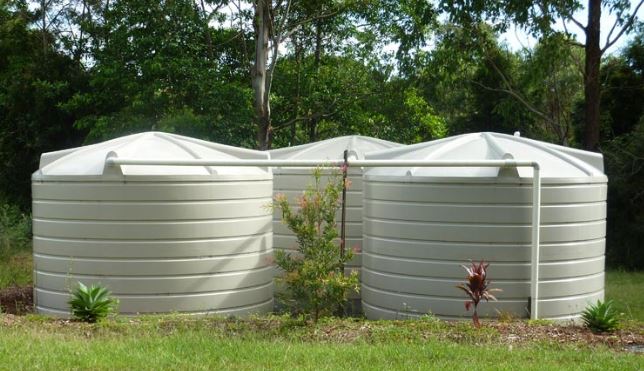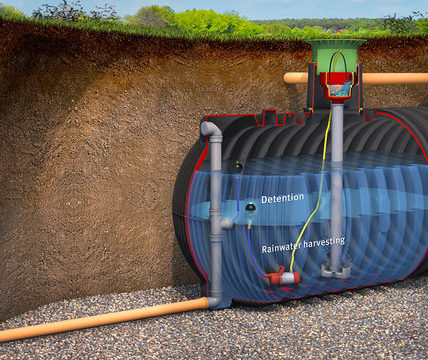Water tanks are a common fitting in many homes. They come in different types varying in size, design and thickness. When it comes to installation, you can either have an above-ground tank or an in-ground water tank. Most in-ground water tanks are made from concrete, but a few are buried poly tanks. In-ground tanks tend to have a larger capacity than above ground tanks. However, above ground tanks are easier to repair and install. The lifespan of water tanks varies depending on the type of the tank and also the installation process.
On average an above ground polyethylene water tank lasts around 10 to 20 years. High density crosslinked polyethylene tanks last around 40% longer than linear polyethylene tanks. This translates to around 15-20 years of service. Underground water tanks, on the other hand, have a longer lifespan when compared to above- ground tanks. Considering most of them are made from concrete, they can give you a whole lifetime of service. Buried poly tanks are the ones that are limited due to their low durability. Despite the long lifespan of water tanks, other factors determine how long a tank would last.
The type of water you store
More often than not, the water in our water tanks is not fresh water. Most tanks harbour water collected from roof gutters or borehole water. Acid rain is a popular occurrence and sometimes the water collected in the tanks is equally as acidic. Acid rain can leach the interior coating of a tank and leave the tank vulnerable. Acids are harsh on polyethylene tanks due to the chemical attack on plastics. Other impurities can also cause serious chemical damage to water tanks. However, the degree of damage is dependent on the construction of the tank. Some tanks are built to be resilient and hold even the harshest impurities in water. High temperatures also augment the chemical reactions in water tanks causing damage.
Installation
Where you install your tank determines how many years it will last. Above ground, tanks are vulnerable to damage. UV rays from the sun can damage poly tanks. The rays cause physical and chemical changes that damage the tank. However, most polyethylene tanks have UV stabilizers compounded into the resin to offer protection against harmful UV rays. Moreover, most tanks have a uniform thickness from top to bottom. This means the top of the tank gets adequate protection from direct light. Some tanks are usually installed in a shed or inside the frame of the roof. Such tanks are protected from direct sunlight and they tend to last longer.
Protection from physical damage
Above ground, tanks are prone to physical damage. It is recommended to install a barrier around the tank to prevent vandals from damaging it. Moreover, a perimeter fence also ensures safety around buried tanks. Vandalism causes physical damage that reduce the lifespan of a tank. With a perimeter fence around the tank can last for years. Moreover, branches from trees and poor weather can also damage your tank if it’s left exposed.
The climate.
Above ground, tanks are exposed to harsh weather conditions. At the event of a hail storm, your tank can sustain numerous damages. Strong winds can also topple an empty tank. Unlike underground tanks, above ground tanks undergo temperature variations. Since the tanks are mostly made from polyethylene they expand on hot days and contract on cold days. This cycle of expansion and contraction caused physical stress on the tank and this can lead to damage. Moreover, when water freezes it starts expanding as the temperatures reduce. Since the tank is simultaneously contracting, pressure builds up in the tank causing damage. Therefore, if you are in an area with weather extreme weather conditions that vary, your tank may not last for too long.
Piping
The piping system is often overlooked when it comes to storage tanks. Polyethylene tanks change in size due to simple outdoor temperature changes. Therefore, the use of flexible expansion joints is necessary for all sidewall connections. When a rigid pipe is used, the tank’s expansion and contraction are limited leading to stress build up and leaks. Moreover, the process piping has to be supported in a manner that will prevent stress on the tank. Unnecessary weight hanging from the water tank will cause undue stress and damage to the tank. Expansion joints protect your tank from pump vibration, the weight of process piping and expansion issues.
There are some things you can do to ensure your tank maintains a long lifespan. A routine maintenance check-up helps to fix problems before they become grave. Leaks can be sealed and any undue stress on the tank can be relieved before causing damage. Moreover, it is recommended to clean your water tank at least once a year. This prevents the build-up of any toxic materials in the tank and prevents clogging of the pipes. If you cannot keep your tank out of the sun, you can paint the outside to prevent UV damage. Moreover, buying a high-quality tank guarantees years of service. If you are keen to prevent any damage to your water tank you will definitely enjoy years of service.
Read Also:




